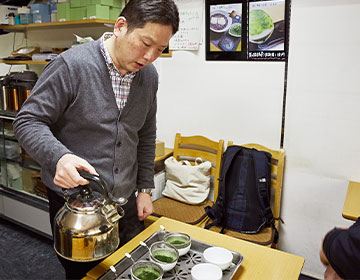Smell and taste the tea to determine its origin and variety.
This appraisal method is known as “bai-ken ni kakeru” or “internal quality review.” A measured amount of tea leaves is placed in an appraisal tea bowl, and hot water is poured over them to reveal the leaves’ shape, flavor, color, aroma, and all other characteristics. There are only a dozen or so “tea masters” in Japan who have achieved the rank of “tea master 10th dan,” and they are true masters of their craft.
They identify the unique characteristics of tea that vary by region and year, and design ways to bring out those characteristics. They also provide advice to customers and feedback to tea producers. Among these few Tea Masters of the Tenth Degree is Takuro Oyama of “Shimokita Chaen Oyama” in Shimokitazawa. Oyama, who has been a tea master at this shop since 1970, was certified as a Tea Master of the Tenth Degree in 2003.
“My family ran a Japanese tea specialty store, but as a child, I didn’t particularly like tea. Tea that was handled carelessly didn’t taste good to a child’s palate. I wanted to learn about the unique characteristics of tea leaves and how to bring them out. Additionally, if I could master the appropriate brewing method tailored to a child’s perspective, I could create tea that is easy to drink. I find it very enjoyable to create tea while considering who will drink it, when they will drink it, and what kind of mood they will be in.”
Even with the same tea leaves, changing the water temperature by 5 degrees can drastically alter the aroma and taste.
“It’s often said that tea shouldn’t be brewed with boiling water, but high-quality tea leaves won’t taste bad even with boiling water. For example, if you’re about to tackle a challenging task,
warmer water is better, while cooler water is better when you want to relax. For me, the conditions for good tea are that it is not boring to drink. Even if you can’t immediately detect any particular characteristics, it is not tiring to drink. Also, if it still tastes good even after it has cooled down, that is a sign of high quality.”
What a tea master can do is “bring out the potential of the tea leaves.”
“Even the most famous Yabukita variety still has untapped potential. There must be a way to enjoy it even more deliciously.”
There are no tea plantations in Shimokitazawa. However, it is a place where carefully selected tea leaves from across the country gather. When these leaves are meticulously selected and blended by experts, tea that captivates and gains the support of many people is born.





